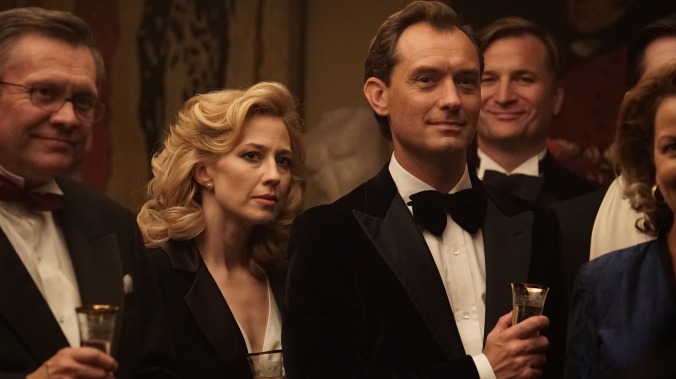Sean Durkin’s terrific The Nest is a haunted house movie without the ghosts

Note: The writer of this review watched The Nest from home on a digital screener. Before making the decision to see it—or any other film—in a movie theater, please consider the health risks involved. Here’s an interview on the matter with scientific experts.
It doesn’t take long to realize that The Nest’s title is meant sarcastically, not unlike referring to Mount Everest as “the hill.” Nobody would ever think of the film’s primary location—a gloomy, rundown mansion in Surrey, England—as cozy or nurturing, much less as the ideal place to raise a brood. Still, that’s where ambitious patriarch Rory O’Hara (Jude Law) drags his otherwise American family after he lands a job in his native country, which he’d apparently left many years earlier. Set sometime during the Reagan administration (probably around 1986 or 1987), The Nest impassively observes the emotional upheaval that this trans-Atlantic move inspires, with a special emphasis on the anxiety of inhabiting a house that seems designed for about 50 people who are all at least 100 times richer than you. For Rory’s wife, Allison (Carrie Coon), and the couple’s two teenage kids (Oona Roche and Charlie Shotwell), it’s an extreme version of culture shock, exacerbated by Rory’s increasingly desperate, delusional effort to make it work.
It’s been nine long years since The Nest’s writer-director, Sean Durkin, made a splash with his superb feature debut, Martha Marcy May Marlene. (In between, he directed a miniseries, Southcliffe, for England’s Channel 4.) That film was fundamentally a triumph of editing, cutting back and forth between different time periods in a way that made past and present feel interchangeable. Here, Durkin has teamed up with the great Hungarian cinematographer Mátyás Erdély (the original Miss Bala, Son Of Saul, Sunset), and together they’ve fashioned something remarkable: an utterly non-supernatural haunted house story. Nothing overtly creepy or menacing ever happens, with the exception of one moment in which a door is mysteriously open after Allison is sure that she’d locked it. Yet The Nest deliberately replicates the ominous look and feel of a slow-burn horror movie, with establishing shots held just a beat too long, shadows that swallow up corners of the room, and physical distance between characters that generates constant free-floating unease. This approach may well frustrate genre buffs who jump to the wrong conclusion early on, but it provides a startlingly fresh angle on otherwise routine domestic discord.
Durkin, who was born in 1981, lived in Surrey himself as a child (albeit not in a mansion), and reportedly based the screenplay in part on his own memories. Without indulging in cheap signifiers, the film accurately remembers countless details from the ’80s; viewers of a certain age will nod in recognition when teen daughter Samantha hears the Thompson Twins’ “Hold Me Now” start up on her radio/cassette deck and practically lunges across the room to hit “record.” But the period itself isn’t especially important, except perhaps insofar as it gives Allison even more reasons to feel perpetually belittled. (Introduced at a posh function as “Mr. and Mrs. Rory O’Hara,” she shakes someone’s hand and politely adds, “My name is Allison—that might have been confusing.”) What matters is the sense of dislocation, which is newly corrosive to most of the family but has seemingly plagued Rory for his entire life. It’s as if he felt an unconscious need to impose the burden he carries onto his loved ones, and the only way he could think to do so was to relocate them somewhere that they clearly don’t belong. Now everybody’s got impostor syndrome!
Even if you’re not entirely sold by the idea of an Antonioni-esque alienation drama shot as if it were I Am The Pretty Thing That Lives In The House (and why the hell wouldn’t you be?!), The Nest is well worth seeing just for its two central performances. Six years after her galvanizing supporting turn in Gone Girl, Coon finally gets a big-screen lead role worthy of her brittle genius; Allison brooks no nonsense from anybody, least of all from herself. (Subtlest, funniest touch: her microscopic glance at the cigarette she’s holding, right after she angrily yells, “Maybe it’s this poisonous fucking house!”) Law’s even more impressive, making Rory aggressively hearty and jovial with an unmistakable undercurrent of self-loathing—he’s like an unholy hybrid of The Talented Mr. Ripley’s Dickie Greenleaf (the role he actually played) and Tom Ripley. (Coon is sometimes made up to resemble Cate Blanchett, just to make things more Ripley-esque.) Still, The Nest’s true star is that cavernous 15th-century mansion, which provides Durkin and Erdély with endless opportunities to carve out sinister voids that threaten to swallow this nuclear family whole. There was no need to include multiple scenes involving a heavily metaphorical dead horse (the movie’s one major flaw); nor did this haunted house require actual ghosts. Its sheer oppressiveness is more than enough.